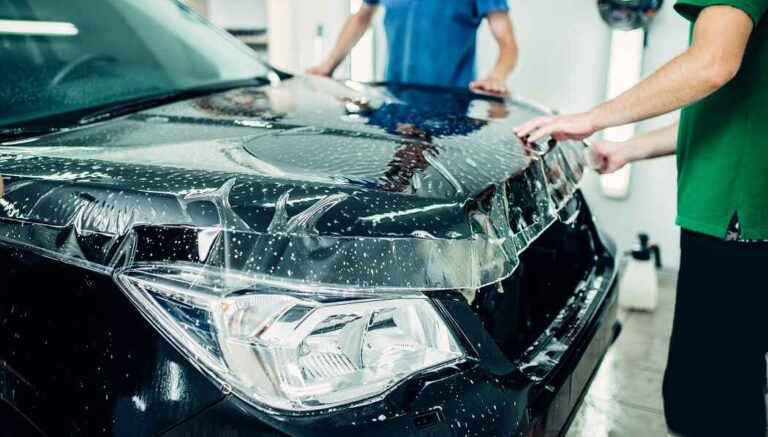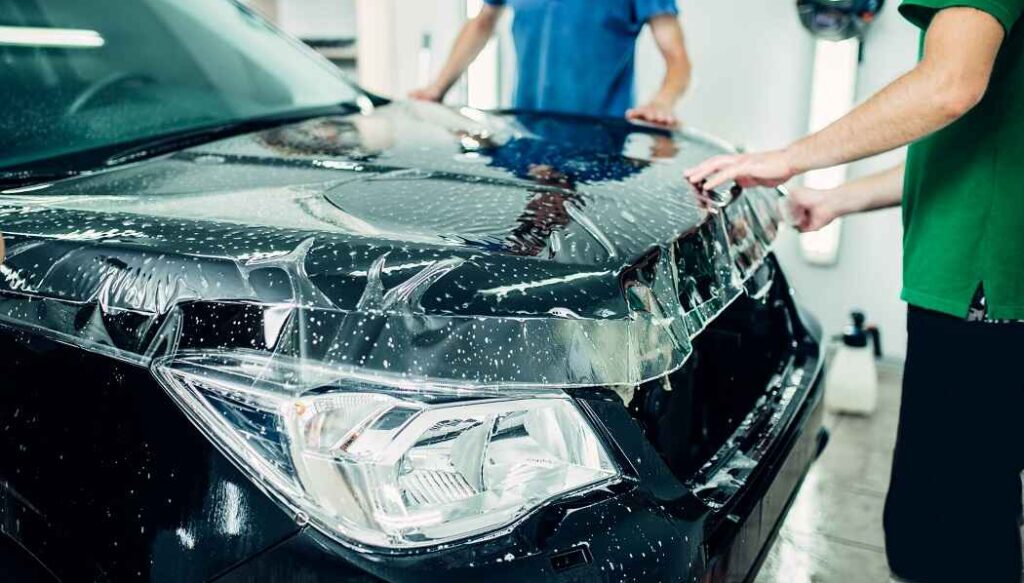
Does Paint Protection Film Damage Paint?
Paint protection film (PPF) doesn’t damage paint. This transparent, thermoplastic urethane film helps to shield a vehicle’s paintwork from many other potential damages.
Automotive enthusiasts often invest significant time and effort in maintaining the pristine appearance of their vehicles. To safeguard the exterior surfaces, they turn to various protective solutions, one of which is paint protection film (PPF).

In this article, we’ll explore the truth behind the potential impact of PPF on automotive paint. We’ll discuss in detail – does paint protection film damage paint, or does it serve as a reliable shield against the hazards of everyday driving?
What Is Paint Protection Film (PPF)?
Paint Protection Film (PPF) is also known as clear film. It is a transparent, thermoplastic urethane film. It is used to the outside surfaces of vehicles to guard them from harm caused by debris, rocks, and scratches. It is a durable and self-healing film that can provide protection to the vehicle’s paintwork.
PPF is typically applied to high-impact areas such as the hood, fenders, bumper, mirrors, and door edges, but it can also be applied to the entire vehicle for comprehensive protection. The film is designed to be nearly invisible. It allows the original paint color and finish to shine through.
The primary purpose of PPF is to prevent damage to the vehicle’s paintwork. It acts as a barrier against chips, scratches, and stains. Moreover, it offers some level of resistance against UV rays, oxidation, and fading.
PPF is commonly installed by professionals who have the necessary expertise to ensure a precise application. It is a popular choice among car enthusiasts and those seeking long-term protection for their vehicles.
Does Paint Protection Film Damage Paint?
Paint protection film is specifically designed to protect the paint on vehicles and does not damage it. Some people believe that applying a film to the surface of the paint may cause harm. However, PPF is formulated with advanced technologies that allow it to adhere to the paint without causing any adverse effects.
One common misconception regarding PPF and paint damage is that the adhesive used to attach the film can harm the paint when removed. But in real, modern PPF products are designed with advanced adhesive systems that are gentle on paint. When applied and removed correctly by a professional, PPF does not cause any damage or leave residue on the paint.
Expert opinions and studies also support the notion that PPF does not damage paint. Many automotive professionals recommend the use of PPF as a means of protecting a vehicle’s paint from various external elements. These experts have extensively tested PPF and have found it to be an effective barrier against different minor damages.
Keep in mind, improper installation or removal techniques by untrained individuals can result in unexpected issues. The problems can be like adhesive residue, bubbling, or uneven finish.
Role of PPF in Shielding Car Paint from External Elements
PPF plays a crucial role in shielding a car’s paint from external elements. Below, we’ve described some key roles of PPF in shielding car paint.
Protection against rock chips and scratches: One of the primary functions of PPF is to guard the vehicle’s surface against rock chips and scratches. The film absorbs the impact of small debris and prevents it from reaching the paint surface. It acts as a sacrificial layer, taking the damage instead of the underlying paint.
Shielding from road debris: Various environmental elements like road debris can cause etching or chemical reactions with the paint surface over time. The film prevents direct contact and makes it easier to clean the car.
UV radiation protection: Continuous exposure to the sun’s ultraviolet (UV) rays can fade and deteriorate car paint. PPF contains UV stabilizers that help block harmful UV radiation. This UV protection prevents color fading, discoloration, and oxidation.
Resistance to discoloration and staining: PPF has the ability to recover from light scratches and swirl marks through heat and time. This property helps maintain the film’s clarity and prevents it from becoming an eyesore on the car’s surface.
Longevity and removable nature: High-quality PPF is durable and designed to withstand harsh weather conditions. It can last for several years without losing its protective properties. Additionally, when it’s time to remove the film, it can be peeled off without damaging the paint surface.
Factors Influencing Paint Damage with PPF
Though PPF provides excellent protection against many types of paint damage, certain factors can still influence its effectiveness. Let’s find out the factors that can impact paint damage with PPF.
Quality of PPF: The quality of the PPF itself plays a significant role in determining its effectiveness. Higher quality films tend to have better clarity, durability, and resistance to damage. Choose a reputable brand and ensure that the PPF meets industry standards for thickness and performance.
Installation: Proper installation requires skill and experience to ensure that the film adheres smoothly and seamlessly. A poorly installed PPF may have visible edges, bubbles, or debris trapped underneath.
Surface Preparation: The car surface should be thoroughly cleaned, free of contaminants such as wax or oils. Any existing paint defects such as swirl marks should be addressed before installation. Proper surface preparation reduces the risk of paint damage.
Environmental Factors: Factors such as temperature, humidity, and exposure to UV radiation can affect the film’s durability. Prolonged exposure to extreme weather conditions may degrade the film and compromise its protective properties.
Maintenance and Care: Proper cleaning techniques using mild soaps and microfiber towels should be followed to avoid scratching the film. Harsh chemicals and automatic car washes with brushes should be avoided.
Driving Habits: Aggressive driving, off-road excursions, or exposure to road debris can increase the risk of paint damage. While PPF provides a layer of protection, it is not completely impervious to all forms of damage.
Time and Usage: Depending on the quality of the film and its exposure to various factors, it may require periodic replacement. The duration of protection can vary. Check for specific recommendations of your PPF product.
Does Removing PPF Damage Car Paint?
When PPF is properly removed using the correct techniques and tools, it should not cause damage to the car’s paint.
But if the PPF has been improperly removed, there is a possibility to happen something bad. In rare cases, if the PPF is forcefully peeled off, it can potentially pull off paint along with it.
To minimize the risk of paint damage, it is strongly recommended to have PPF removal performed by experienced persons. They are equipped with the appropriate methods and they can safely remove the film without harming the underlying paint.
Final Verdict
When professionally installed, high-quality PPF can effectively shield the car’s paint. It helps preserving the original paint. It can significantly extend the lifespan and overall appearance of a vehicle’s paint job.
However, improper installation and low-quality film can lead to negative effects on the paint. Poor installation techniques may result in adhesive residues or even peeling.
To enjoy the best results from PPF, choose a reputable installer with experience in PPF application. Thus, you can keep your vehicle’s paint safe.
